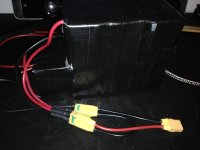Is this the proper way of doing the math?
Controller is a generic 36v (10s) 35 amps
Battery is 36v 10s 22ah 8p I do not know what they use for 18650's, so I cant find the info for nominal or max discharge. Plastic encases the 5s2p 6ah or 5s3p 9ah. The Ryobi ONE+ sleeves are green, they are the normal ONE+ and not the High Performance Ryobi's (probably more discharge?)
35a/8p = 4.375 amps per parallel grouping of 10s.
4.375 amps divided by 10s = 0.4375 amps per 18650 cylinderical cell. Theoretical discharge amps per cell, taking out resistances of joints, tabs and series connection method (I am using 10awg solid copper house wiring).
Controller is a generic 36v (10s) 35 amps
Battery is 36v 10s 22ah 8p I do not know what they use for 18650's, so I cant find the info for nominal or max discharge. Plastic encases the 5s2p 6ah or 5s3p 9ah. The Ryobi ONE+ sleeves are green, they are the normal ONE+ and not the High Performance Ryobi's (probably more discharge?)
35a/8p = 4.375 amps per parallel grouping of 10s.
4.375 amps divided by 10s = 0.4375 amps per 18650 cylinderical cell. Theoretical discharge amps per cell, taking out resistances of joints, tabs and series connection method (I am using 10awg solid copper house wiring).



![IMG_0230[1].JPG IMG_0230[1].JPG](https://endless-sphere.com/sphere/data/attachments/184/184570-b9ef502520d496d2ddfcd4630d94269b.jpg)
![IMG_0231[1].JPG IMG_0231[1].JPG](https://endless-sphere.com/sphere/data/attachments/184/184571-438327507abe63028626e23806ded390.jpg)
![IMG_0233[1].JPG IMG_0233[1].JPG](https://endless-sphere.com/sphere/data/attachments/184/184579-11e30291a20411df2f5d572a74a19af7.jpg)